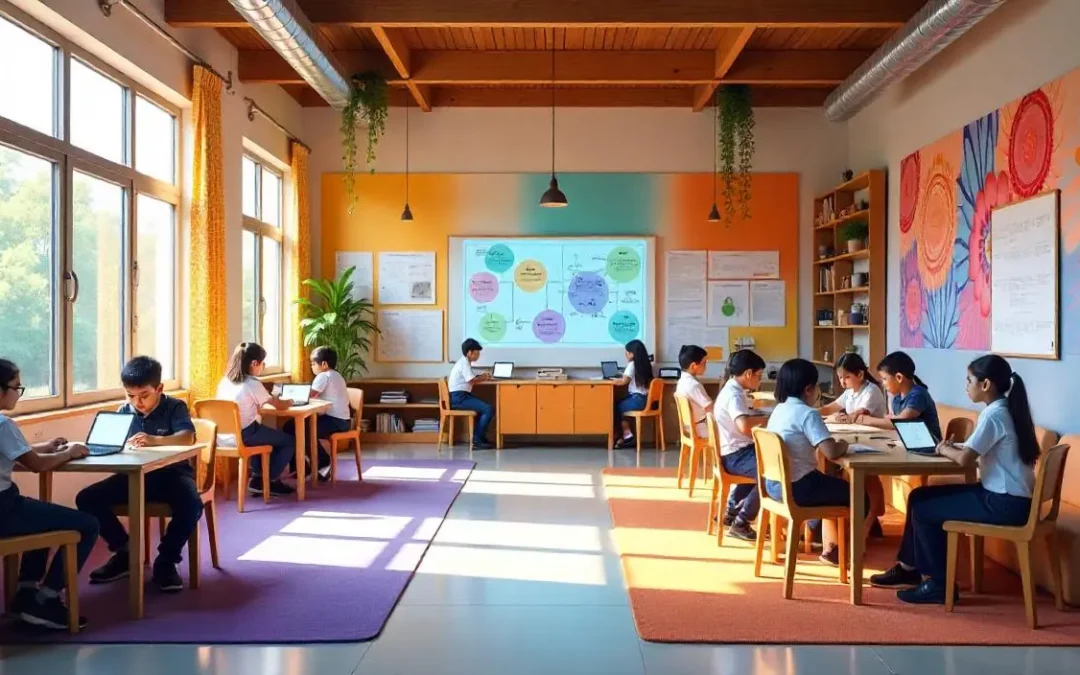Design Thinking Curriculum in Schools: Schools must prepare students for a future that demands creativity, critical thinking, and problem-solving. Design Thinking—a structured, human-centered approach to innovation—offers a powerful way to develop these skills.
For school administrators and teachers, implementing a Design Thinking curriculum is not just about teaching a new subject but transforming the way students learn. However, to integrate this methodology effectively, schools must adopt strategic best practices that ensure a smooth and impactful implementation.
This guide provides actionable insights for administrators and teachers on how to successfully implement Design Thinking in schools and create a dynamic learning environment.
1. Understanding the Core of Design Thinking
Before embedding Design Thinking Curriculum in Schools into the curriculum, it’s essential that administrators and teachers have a clear understanding of its five key stage:
- Empathize – Understanding the needs and perspectives of the users (students, teachers, or community members).
- Define – Clearly articulating the problem that needs solving.
- Ideate – Brainstorming creative solutions.
- Prototype – Developing and testing tangible models or concepts.
- Test – Refining the solution based on feedback and iteration.
Action Steps for Schools:
- Organize professional development workshops on Design Thinking for educators.
- Include Design Thinking principles in school policies and teaching guidelines.
- Create collaborative spaces where teachers can experiment with new teaching strategies.
- By ensuring all educators grasp these principles, schools lay the groundwork for a successful and meaningful curriculum transformation.
2. Aligning Design Thinking with Educational Goals
A Design Thinking Curriculum in Schools must align with the school’s mission and academic objectives to maximize its impact.
How to Integrate Design Thinking Across Subjects:
- Science & Math: Encourage students to develop solutions to real-world STEM challenges, such as climate change or sustainable energy.
- Social Studies: Use Design Thinking to analyze historical events and propose solutions to societal issues.
- Language & Arts: Develop creative storytelling methods, write persuasive campaigns, or design interactive exhibits.
Steps for Administrators & Curriculum Developers:
- Ensure Design Thinking aligns with national and state educational standards.
- Integrate Design Thinking into project-based learning modules.
- Provide flexibility in lesson planning so teachers can incorporate problem-solving activities.
This approach ensures that the Design Thinking Curriculum in Schools enhances existing curricula rather than being an additional burden for educators.
3. Equipping Teachers with the Right Training
Teachers are at the heart of this transformation, and they must be well-prepared to facilitate Design Thinking Curriculum in Schools activities effectively.
Professional Development Strategies:
- Conduct interactive training workshops with hands-on exercises.
- Offer online courses and certifications on Design Thinking methodologies.
- Encourage teachers to collaborate in professional learning communities (PLCs).
- Provide mentorship programs where experienced educators coach others.
By investing in teacher training, administrators ensure that educators feel confident, capable, and motivated to implement the Design Thinking Curriculum in their classrooms.

4. Creating an Engaging and Collaborative Classroom Environment
For Design Thinking to thrive, classrooms must foster collaboration, creativity, and experimentation.
Practical Ways to Redesign Learning Spaces:
- Use flexible seating (movable desks, bean bags, round tables) to encourage teamwork.
- Introduce innovation labs or makerspaces equipped with tools like 3D printers, craft supplies, and coding kits.
- Incorporate visual brainstorming spaces (whiteboards, sticky notes, interactive screens).
- Design cross-grade collaboration opportunities where students mentor one another.
By designing classrooms to reflect an innovation-driven culture, students naturally develop problem-solving skills and teamwork. Integrating specialized subjects like an Ethical Hacking Course can further enhance these skills, encouraging students to think critically and collaboratively in tackling cybersecurity challenges.
5. Encouraging Hands-On, Real-World Problem Solving
Students learn best when they can apply their knowledge to real-world scenarios.
Project-Based Learning Ideas:
- Sustainability Challenge: Students design eco-friendly solutions for school waste management.
- Community Well-being: Develop mental health awareness programs.
- STEM Innovation: Create prototypes for accessible technology to assist disabled individuals.
Administrator’s Role:
- Partner with local organizations and industries to give students real-world exposure.
- Encourage interdisciplinary projects where multiple subjects contribute to a single solution.
- Provide a platform for students to present their solutions in school-wide exhibitions or competitions.
This hands-on approach increases student engagement and prepares them for future careers in innovation-driven fields.
6. Building a Culture of Risk-Taking and Growth Mindset
There should not be any fear of failure as it destroys the effort to innovate. Schools must normalize experimentation and iteration by fostering a growth mindset.
Strategies for Administrators & Teachers:
- Reinforce that mistakes are learning opportunities.
- Shift from grading final results to assessing the process.
- Celebrate creative failures by showcasing lessons learned.
- Provide student reflection activities to analyze what worked and what didn’t.
By fostering a psychologically safe environment, students feel empowered to take risks and develop resilience.
7. Leveraging Technology for Design Thinking
Technology is a game-changer in implementing Design Thinking, allowing students to prototype, test, and iterate ideas more effectively.
Recommended Tools for Schools:
- Miro, Trello, or Google Jamboard – for brainstorming and ideation.
- Tinkercad, SketchUp – for 3D modeling and prototyping.
- Scratch, Python – for coding-based solutions.
- VR & AR applications – for immersive learning experiences.
Administrator’s Role:
- Invest in accessible ed-tech solutions that support Design Thinking.
- Train teachers in digital tools that enhance collaboration and problem-solving.
- Encourage blended learning models that integrate technology with hands-on experiences.
By embracing technology, schools can elevate Design Thinking to new levels of innovation.
8. Measuring Success: Assessing Design Thinking Impact
To ensure the effectiveness of a Design Thinking curriculum, assessment frameworks should measure student learning and progress.
Assessment Methods for Administrators & Teachers:
- Portfolio-Based Assessments: Students document their problem-solving journeys.
- Rubrics for Creativity & Collaboration: Evaluate teamwork and originality.
- Self-Reflection Surveys: Encourage students to assess their growth.
- Teacher Feedback: Use peer and mentor feedback to refine student projects.
By shifting from traditional exams to process-based assessments, schools capture the true impact of Design Thinking.
9. Establishing Partnerships with Industry and the Community
Real-world exposure enhances students’ ability to apply Design Thinking beyond the classroom.
Ways Administrators Can Build Partnerships:
- Organize guest lectures and workshops with design professionals.
- Collaborate with local businesses and NGOs for real-world projects.
- Set up internship and mentorship programs for students.
- Host Design Thinking fairs to showcase student innovations.
These partnerships help students connect classroom learning to industry challenges, preparing them for future careers.
Conclusion
- Aligning it with educational goals
- Training educators effectively
- Encouraging hands-on, real-world learning
- Creating collaborative learning spaces
- Embracing technology and assessment frameworks
- Partnering with industry for real-world exposure
By integrating these best practices, schools can prepare students for the future, equipping them with the skills needed to thrive in an innovation-driven world.
Contact our team at Techradiance today to set up a Design Thinking Lab in your school!

